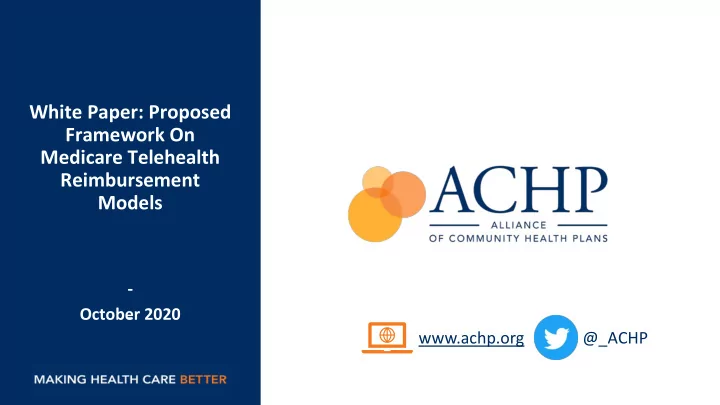

White Paper: Proposed Framework On Medicare Telehealth Reimbursement Models - October 2020 - www.achp.org @_ACHP
TELEHEALTH PAYMENT MODEL To illustrate a financially sustainable path forward PURPOSE for telehealth past the public health emergency Why Is ACHP Offering A To ensure telehealth payment is aligned with high- New Payment quality care Model for Medicare Telehealth? To guarantee patients, providers and payers maintain highly coordinated and convenient care for all PAGE / 2
Medicare FFS incentivizes TELEHEALTH Fear of increased health care PAYMENT MODEL volume over value, leading to costs from Congress and the CURRENT BARRIERS unnecessary care and financial Administration. exploitation. Barriers to Full parity with in-person visits Insufficient infrastructure Robust is not sustainable to achieve requiring significant Telehealth system-wide savings. investment. Utilization Offer a thoughtful transition process ACHP’s Solution from FFS to value-based arrangements in telehealth. PAGE / 3
TELEHEALTH PAYMENT MODEL Support and Reform Prove and Grow TWO FRAMEWORKS The relaxed licensing guidelines for health care practitioners will not be maintained past the public health emergency Originating and distant site flexibilities under the public health Key emergency will be made permanent Assumptions Non-physician practitioners will continue to qualify for that Apply to reimbursement Both Frameworks Geographical requirement that patients be located in rural areas will be removed permanently HHS will have the authority to issue regulatory guidance on modern technology Payment parity will continue for five years to allow for post- pandemic stability, adjustment and technology investment PAGE / 4
Phase 1 TELEHEALTH PAYMENT MODEL • Announce that Medicare will pay full parity for telehealth SUPPORT AND services for 5 years REFORM • National education campaign promoting virtual care Phase 2 Phased In • Collect data to determine best balance of in-person and approach to telehealth services post-PHE Analyze, • Independent entity analyzes data Build and • Public-private collaboration creates new payment model Implement Phase 3 • Test payment model created by public-private collaboration in Year 5 • CMS issues proposed rule that establishes telehealth PAGE / 5 payment adjustments based on the analysis and testing in Years Four and Five
TELEHEALTH PAYMENT MODEL The Matrix of Care would ensure that Medicare only reimburses SUPPORT AND REFORM for services that benefit patients. Providers will be paid PMPM w/ rewards for higher-quality services The type of visit is segregated into four categories: Initial Intake/New Patient Built Upon a Matrix of Care Follow-Up Visit to Evaluate Chronic-Care Management/Routine Visit Telehealth Diagnostic Visit Effectiveness These types of visits will be measured and reimbursed according to each medical specialty’s effectiveness in a virtual setting. Telehealth Success Telehealth Potential PAGE / 6 In-Person Preferable
Support and Reform Timeline Year 3 Year 5 Year 1 Announce that Medicare pays Collect Data Test payment model full parity Review and report data CMS issues rule National education campaign Committee begins work Collect data Collect Data Review and report data Contract with independent entity Committee refines Create public-private committee proposed model Year 2 Year 4 PAGE / 7
TELEHEALTH PAYMENT MODEL Medicare will reimburse at parity for a limited number of telehealth services for 5 years: PROVE AND GROW Chronic care management Mental and behavioral health Follow-up / preventive care Focusing on Primary and Preventative Care After Year Five, all telehealth reimbursements will reduce to 80% of in-person visits. PAGE / 8
Providers will report data to demonstrate cost-effective and TELEHEALTH PAYMENT MODEL high-quality care PROVE AND GROW Eligible to receive bonuses for high quality and lower cost services based on: 1. Milliman Waste Calculator 2. Various Market Metrics that analyze local market cost Reimbursement savings based on a weighted average of metrics: Based on High Quality Metrics • Patient reported outcome measures (10%), • Local hospital re-admission rates for in-patient care (30%) • No-show patient rates (20%) • Preventative care adoption (40%) PAGE / 9
Prove and Grow Timeline Year 3 Year 5 Year 1 Announce that Medicare pays Collect Data CMS issues revised rule full parity Create committee National education campaign Collect Data Committee makes recommendation based on CMS issues rule on how data is data analysis reported and how metrics apply for bonus payments Year 4 Year 2 PAGE / 10
TELEHEALTH PAYMENT MODEL • Is this to address Medicare FFS or Medicare Advantage telehealth Q&A benefits? • Is this under CMMI authority or not? • Who collects the data? Why wouldn’t you start collecting data in Additional Year 1? Aspects to Consider • How will providers have a predictable business model under model #2? • Isn’t there a need for capital like HITECH’s funding of E.H.R. systems? PAGE / 11
Recommend
More recommend